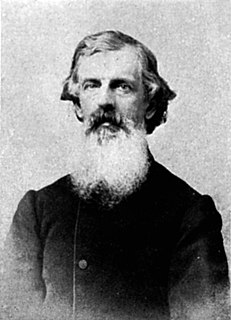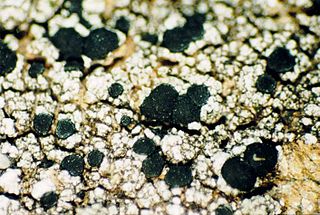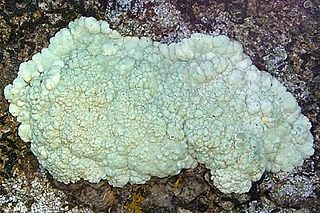
Edward Tuckerman was an American botanist and professor who made significant contributions to the study of lichens and other alpine plants. He was a founding member of the Natural History Society of Boston and most of his career was spent at Amherst College. He did the majority of his collecting on the slopes of Mount Washington in the White Mountains of New Hampshire. Tuckerman Ravine was named in his honor. The standard botanical author abbreviation Tuck. is applied to species he described.

The Lecanoraceae are a family of lichenized fungi in the order Lecanorales. Species of this family have a widespread distribution.

Lecanora is a genus of lichen commonly called rim lichens. Lichens in the genus Squamarina are also called rim lichens. Members of the genus have roughly circular fruiting discs (apothecia) with rims that have photosynthetic tissue similar to that of the nonfruiting part of the lichen body (thallus). Other lichens with apothecia having margins made of thallus-like tissue are called lecanorine.

Crustose lichens are lichens that form a crust which strongly adheres to the substrate, making separation from the substrate impossible without destruction. The basic structure of crustose lichens consists of a cortex layer, an algal layer, and a medulla. The upper cortex layer is differentiated and is usually pigmented. The algal layer lies beneath the cortex. The medulla fastens the lichen to the substrate and is made up of fungal hyphae. The surface of crustose lichens is characterized by branching cracks that periodically close in response to climatic variations such as alternate wetting and drying regimes.

Lecanora phryganitis is a species of lichen in the family Lecanoraceae. It was described as new to science in 1866 by American botanist Edward Tuckerman.

Lecanora is a species of crustose lichen in the family Lecanoraceae. It was described as new to science in 1864 by American botanist Edward Tuckerman.

Lecanora thysanophora is an eastern North American lichen in the family Lecanoraceae. It is a common crustose species, easily recognized by its sorediate thallus, usually encircled by a grey prothallus.
Lecanora muscigena is a species of lichen in the family Lecanoraceae. It was described as new to science in 2020 by Dag Øvstedal & Alan Fryday. It is found in the subantarctic island of South Georgia, where it grows on ground-dwelling mosses.

Lecanora polytropa, commonly known as the granite-speck rim lichen, is a species of saxicolous lichen in the family Parmeliaceae. A small, inconspicuous species that grows in the cracks of rock surfaces, it has a cosmopolitan distribution and has been recorded on all continents, including Antarctica.
Lecanora solaris is a species of crustose lichen in the family Lecanoraceae. Found in the Altai Mountains in Russia, the lichen was described as new to science in 2019 by Lydia Yakovchenko and Evgeny Davydov. The lichen is similar in general morphology to Lecanora somervellii, but can be distinguished from that species by its small, squamulose (scaly) to marginally lobate umbilicate thallus and the persistent margin of its apothecia. The species epithet makes reference to the bright yellow colour of the lichen.

Loxospora ochrophaea is a species of crustose lichen in the family Sarrameanaceae.
Lecanora achroa is a species of crustose lichen in the family Lecanoraceae. It was originally described in 1876 by Finnish botanist William Nylander from specimens collected in Rodrigues, Mauritius. The lichen is found in Australia, New Zealand, Papua New Guinea, and North and South America.
Lecanora lichexanthona is a species of crustose and saxicolous (rock-dwelling) lichen in the family Lecanoraceae. Found in Brazil, it was formally described as a new species in 2000 by lichenologist Roland Guderley. The type specimen was collected by Klaus Kalb in a closed cerradão between Rio Verde de Mato Grosso and Coxim where it was found growing on siliceous rock. The specific epithet lichexanthona refers to the presence of the chemical lichexanthone as a major secondary in the lichen. Other compounds in the lichen are atranorin, hybocarpone, constipatic acid, and norlichexanthone. Lecanora lichexanthona is only known to occur in cerradão formations in central Brazil, at altitudes between 500 and 850 m.
Lecanora hafelliana is a species of corticolous (bark-dwelling), crustose lichen in the family Lecanoraceae. It is found in South Korea and in China, where it is fairly common on the bark of deciduous trees such as maple, birch, dogwood, and oak. The lichen was formally described as a new species in 2011 by Lei Lü, Yogesh Joshi, and Jae-Seoun Hur. The type specimen was collected by Hur on Mount Baekwoon at an elevation of 1,037 m (3,402 ft). In China, it was recorded growing on the bark of Korean pine. The lichen has a dull whitish to ash-grey crust-like thallus with a definite margin, but lacking a prothallus. Lecanora hafelliana contains several secondary compounds, including atranorin, zeorin, usnic acid, a complex of compounds related to stictic acid, and hafellic acid. Its specific epithet alludes to the presence of this latter compound.
Lecanora microloba is a species of crustose and areolate lichen in the family Lecanoraceae. Found in Poland, it was formally described as a new species in 2010 by Lucyna Śliwa and Adam Flakus. The type specimen was found by the second author in the Hińczowy Żleb gully in the High Tatra Mountains at an altitude of 2,200 m (7,200 ft). Here, in vegetation characteristic of the subnival belt, the lichen was found growing on granite rock that was mylonitized. Lecanora microloba contains secondary compounds: gyrophoric acid, usnic acid, and zeorin as major metabolites, and an unidentified terpene. A distinguishing characteristic of the lichen is the presence of coarse granules in the epithecium that are distinctly bright when shone with polarized light. The specific epithet microloba refers to the minute lobe-like areoles in the thallus margins.
Lecanora substerilis is a species of corticolous (bark-dwelling), crustose lichen in the family Lecanoraceae. It is found in Eastern Europe, in old-growth beech forests of the Carpathian Mountains in the Czech Republic, Slovakia, Romania and Ukraine.
Lecanora ussuriensis is a species of saxicolous (rock-dwelling) lichen in the family Lecanoraceae. It is found in single localities in the Primorsky Krai region of the Russian Far East, as well as in Japan.
Lecanora lojkahugoi is a species of saxicolous (rock-dwelling) crustose lichen in the family Lecanoraceae. It is found in the Russian Far East and in South Korea.









